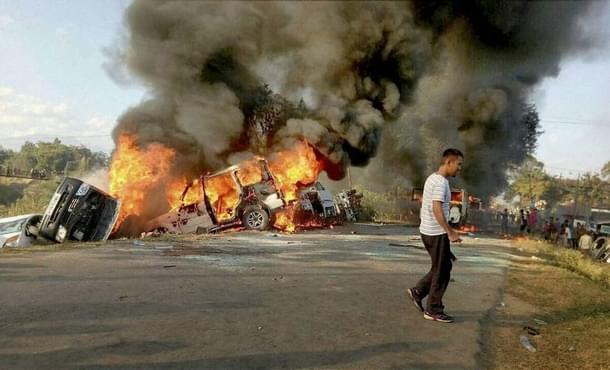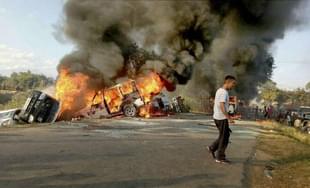Insta
Curfew In Imphal: Here’s All You Need To Know About The Ongoing Violence And Economic Blockade In Manipur
Swarajya Staff
Dec 19, 2016, 09:16 AM | Updated 09:16 AM IST
Save & read from anywhere!
Bookmark stories for easy access on any device or the Swarajya app.


At least 22 cars, buses and other vehicles were torched in Manipur's Imphal East district on Sunday by residents protesting against the Naga economic blockade. Violence spread to more areas, leading to authorities imposing curfew throughout the district as well as in Imphal West.
In wake of the attack, heavily-armed police and paramilitary personnel are patrolling the trouble-prone areas. Internet connectivity has been suspended in the areas affected by violence to prevent the spread of rumours.
The United Naga Council (UNC) imposed an indefinite economic blockade on 1 November following the state government's announcement of the formation of seven new districts. It claims that the creation of new districts in the Naga dominated hill areas will encroach upon and divide the traditional land holdings of Naga tribes.
The blockade has not only crippled trade and normal life, but has also stoked up the existing divide between the valley and the hill populace. According to News 18, insurgency being carried out by various Naga terror outfits in the state has stepped up in the recent past.
Attacks on Manipur Police and other state forces in the last few days has left three policemen dead and 14 others injured. A group around 70 Naga terrorists attacked a police post on Saturday, stealing nine automatic weapons and leaving two policemen injured.
Thus, to protest against the economic blockade and insurgency, angry residents in the valley took to the streets and torched vehicles coming down from the Naga dominated hilly areas.
According to IANS, Police circles and civil organisations fear a communal flare up. This may be the beginning of a repeat of ethnic cleansing witnessed in the 1990s which left over 1,500 dead and dozens of villages destroyed.





